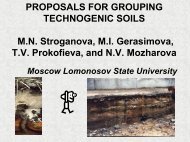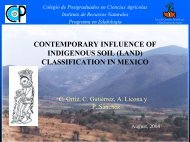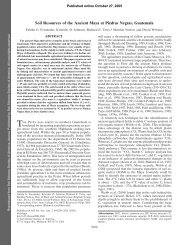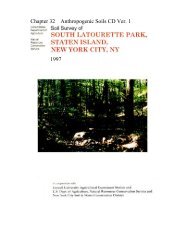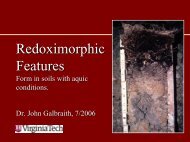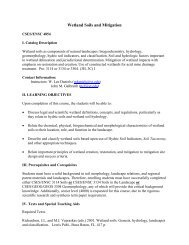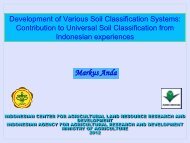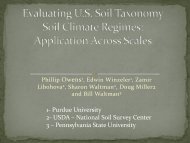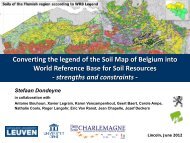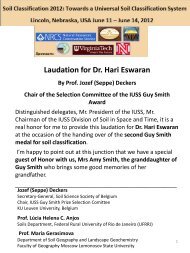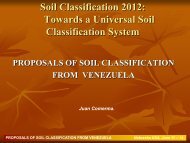Nebraska Soils Field Trip - Virginia Tech
Nebraska Soils Field Trip - Virginia Tech
Nebraska Soils Field Trip - Virginia Tech
Create successful ePaper yourself
Turn your PDF publications into a flip-book with our unique Google optimized e-Paper software.
4th IUSS Soil Classification Conference <strong>Field</strong> Tour Guidebook<br />
COMPETING SERIES: There are no competing series.<br />
GEOGRAPHIC SETTING:<br />
Parent material--18 to 30 inches of clayey alluvium and the underlying loamy alluvium<br />
Landform--flood plains<br />
Slopes--0 to 2 percent<br />
Elevation--700 to 1,260 feet above sea level<br />
Mean annual air temperature--46 to 56 degrees F.<br />
Mean annual precipitation--19 to 36 inches<br />
Frost-free period--135 to 185 days<br />
GEOGRAPHICALLY ASSOCIATED SOILS: These are the Albaton, Blake, Percival,<br />
Grable, Haynie, and Modale soils.<br />
Albaton--are in the slightly lower landscape positions, have a saturated zone within a depth of 1<br />
foot during March to June in most years, and have a clay content of 50 to 60 percent throughout<br />
the particle-size control section<br />
Blake--are in landscape positions similar to those of the Onawa soils and have a clay content of<br />
22 to 35 percent throughout the particle-size control section<br />
Percival--are in the slightly higher landscape positions, have a clay content of less than 10<br />
percent in the lower half of the particle-size control section<br />
Grable--are in the higher landscape positions, have a clay content of 12 to 16 percent in the upper<br />
half of the particle-size control section, and do not have a saturated zone within a depth of 6 feet<br />
during April to June in most years<br />
Haynie--are in the slightly higher landscape positions, have a clay content of 15 to 18 percent<br />
throughout the particle-size control section, and have a saturated zone between depths of 4 to 6<br />
feet during April to June in most years<br />
Modale--are in the slightly higher landscape positions, have a clay content of 10 to 18 percent in<br />
the upper third to upper half of the particle-size control section, and have a saturated zone<br />
between depths of 1 to 3 feet during April to June in most years<br />
DRAINAGE AND PERMEABILITY:<br />
Drainage class--somewhat poorly drained--a saturated zone occurs within depths of 1 to 3 feet<br />
during March to June in most years and is considered apparent<br />
Permeability--slow in the clayey alluvium and moderate or moderately rapid in the underlying<br />
loamy alluvium<br />
Surface runoff potentiallow or medium<br />
Flooding--rare to occasional flooding with very brief or brief duration during the months of<br />
February to November from precipitation events and snowmelt and flooding from streambank<br />
overflow is limited where dams and levees protect areas<br />
USE AND VEGETATION:<br />
Most areas are cultivated. The principal crops are corn, soybeans, and small grains. Some areas<br />
are land-leveled and irrigated. The native vegetation is big bluestem, little bluestem, western<br />
wheatgrass, indiangrass, switchgrass, and other grasses of the tall grass prairie.<br />
84



